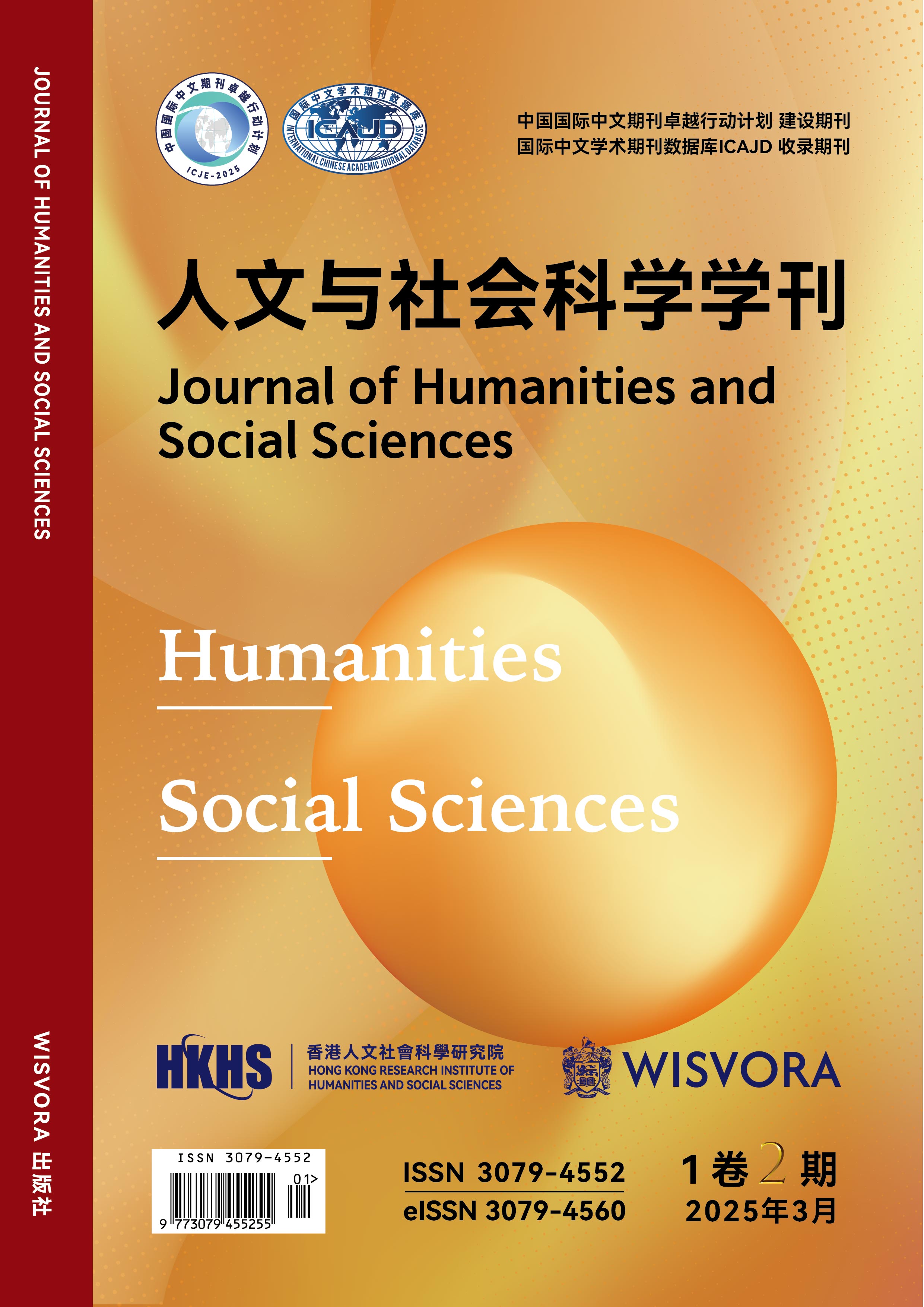孤独到连接:数字时代下街舞亚文化与青年身份建构
DOI:
https://doi.org/10.70693/rwsk.v1i2.507Keywords:
网络亚文化;社群互动;数字身份;情感支持Abstract
本研究不同于传统聚焦于街舞文化被商业化与主流化过程的考察,而是将视野转向数字时代下街舞亚文化如何帮助青年实现从“孤独”到“连接”的身份建构与情感支持。通过对14位街舞青年的深度访谈,结合深度访谈的方法,研究发现街舞青年通过数字平台打破了地域和文化界限,逐渐从孤立个体转变为紧密相连的社群成员。数字平台为街舞青年提供了表达自我与跨文化交流的机会,使他们在社群互动中增强社会参与感、构建积极自我认同,并在情感支持和身份构建中获得成长。本文旨在通过青年街舞文化现状,补充对亚文化群体如何利用数字平台进行身份建构的观察,为理解数字化时代青年文化的变迁提供新的理论视角。
References
The Sporting News.Olympics Last Supper controversy, explained: Why drag performance during 2024 opening ceremony is drawing backlash.[EB/OL]. (2024-07-29)[2024-11-20].https://www.sportingnews.com/us/olympics/news/olympics-last-supper-controversy-explained-2024-opening-ceremony/cd6a1ccc666cc8c182ec6244.
中国日报网.中国国家主席习近平在纪念和平共处五项原则提出70周年大会上的讲话全文.[EB/OL]. (2024-06-28)[2024-11-20].http://global.chinadaily.com.cn/a/202406/28/WS667e6f2ea31095c51c50b638.html.
Paglione, V., Magrath, J., McDonough, M. H., Din, C., & Kenny, S. J. (2023). ‘Promoting wellness, having fun, and creating community’: a dance instructor’s pedagogical practices and perspectives on the influence of community dance classes for older adults. Research in Dance Education, 1-18.
Griffiths, L. E. (2023). Dancing through social distance: Connectivity and creativity in the online space. Body, Space & Technology, 22(1), 65-81.
Coleman, G. (2015). Hacker, hoaxer, whistleblower, spy: The many faces of Anonymous. Verso books: 15-20.
Burgess, J., & Green, J. (2018). YouTube: Online video and participatory culture. John Wiley & Sons: 55-66.
Zhu, H., Feng, D., & Chen, X. (2024). Introduction: Approaching Social Identities and Discourses in Chinese Digital Communication. In Social Identity and Discourses in Chinese Digital Communication (pp. 1-21). Routledge.
Mkrtchyan, M. (2023). LINGUISTIC SUBCULTURE: LITERARY ARGOT AND ITS TRANSLATIONAL INSIGHTS (IN “A CLOCKWORK ORANGE” BY ANTHONY BURGESS). PHILOLOGICAL RESEARCHES, (VII): 338-350.
Luu, V. T., & Williams, J. P. (2024). How K-pop fans utilize conventional and subcultural frameworks to construct fan identities: A case study of Seungri and the Burning Sun scandal. Deviant Behavior, 1-14.
Akarachantachote, P. (2023). Communication for Social Space Creation of Board Games Subculture in Thailand. Journal of Communication Arts, 41(1), 125-143.
Chang, J., He, R., & Ren, H. (2021). The semiotic guerrilla: Internet subcultures as political resistance in China. Journal of Media and Communication Studies, 13(4), 110-120.
Bhoj, R., Thapa, R., & Chowdhury, A. R. (2024). Effects of recreation of subcultures on social media on the subculture, inter-subculture community and intra-subculture community individuals. Fashion, Style & Popular Culture, 11(3-4), 555-571.
Yin, Y., & Xie, Z. (2024). Playing platformized language games: Social media logic and the mutation of participatory cultures in Chinese online fandom. New Media & Society, 26(2), 619-641.
Yoon, K. (2019). Transnational fandom in the making: K-pop fans in Vancouver. International communication gazette, 81(2), 176-192.
Han, X. (2022). Platform as new" daddy": China's gendered wanghong economy and patriarchal platforms behind. Internet Policy Review, 11(1), 1-34.
Branger, L. A. G. (2023). Mediated Identities: How Facebook Intervenes in the Virtual Manifestation of Our Identities. Virtual Identities and Digital Culture, 38-47.
Perasović, B., Mustapić, M., Ibañez Garzaran, Z. L., Mulari, H., & Hofreiter, R. (2023). Youth in conflict: space and subculture. Journal of Youth Studies, 26(3), 368-386.
Zhao, Y. (2022). Teaching traditional Yao dance in the digital environment: Forms of managing subcultural forms of cultural capital in the practice of local creative industries. Technology in Society, 69, 101943.
Tsaliki, L. (2022). Constructing young selves in a digital media ecology: Youth cultures, practices and identity. Information, Communication & Society, 25(4), 477-484.
Guerra, P. (2020). Under-Connected: Youth subcultures, resistance and sociability in the Internet age. Hebdige and Subculture in the Twenty-First Century: Through the Subcultural Lens, 207-230.
Ding, W. (2022). Emoticons Production of Bing Dwen Dwen: Meme, Online Socialization and Youth Subculture. BCP Social Sciences & Humanities, (17), 274-284.
Osadcha, L. V. (2022). Personal identity in the space of virtual culture: on the example of geek and glam subcultures. Anthropological Measurements of Philosophical Research, (22), 90-98.
Johnson, A. (2021). Copyrighting TikTok dances: choreography in the internet age. Wash. L. Rev., 96, 1225.
Kavakci, E., & Kraeplin, C. R. (2017). Religious beings in fashionable bodies: The online identity construction of hijabi social media personalities. Media, Culture & Society, 39(6), 850-868.
Wang, Y. (2023). Virtual love experience in love and producer: Exploring perceptions of love, romance and gender in otome game player communities in China. Media and Communication Research, 4(10), 5-11.
Yuexin, L. (2023). Research on the Current Situation and Strategies of Street Dance Competition Marketing. Academic Journal of Business & Management, 5(15), 36-40.
Pritchard, R., Darko, N., & Stevenson, E. (2024). Enhancing community engagement, public involvement, and social capital through researchers’ participation in community dance projects: unexpected outcomes in underserved communities. Research Involvement and Engagement, 10(1), 79.
Koutsougera, N. (2018). Women's Performativities and Gender Politics in Hip Hop and Street Dance Cultures of Greece. The Popular as the Political, 38, 22.
Meneau, V. (2024). Queer dancers’ experiences in the dancesport world: exclusion, invisibilisation and assimilation. Equality, Diversity and Inclusion: An International Journal, 43(9), 55-70.
Downloads
Published
How to Cite
Issue
Section
License
Copyright (c) 2025 唐家杰

This work is licensed under a Creative Commons Attribution 4.0 International License.



















 人文与社会科学学刊© 2025 已获得
人文与社会科学学刊© 2025 已获得 

